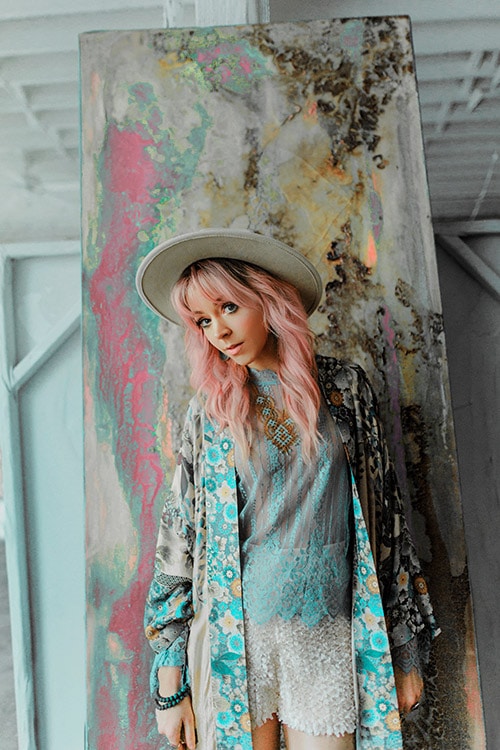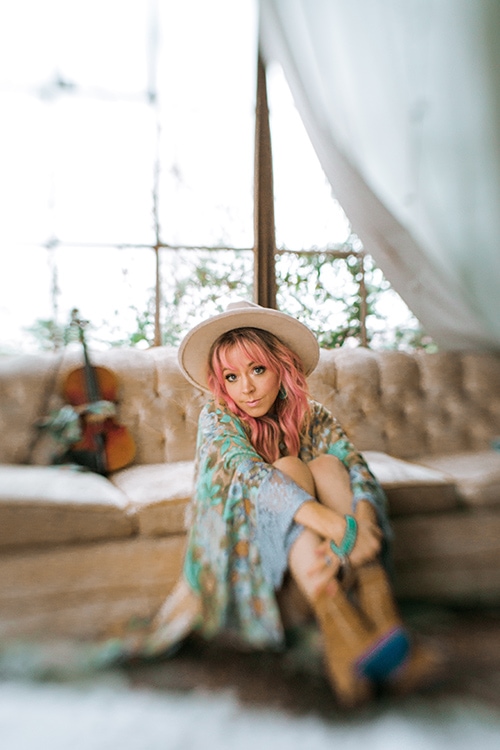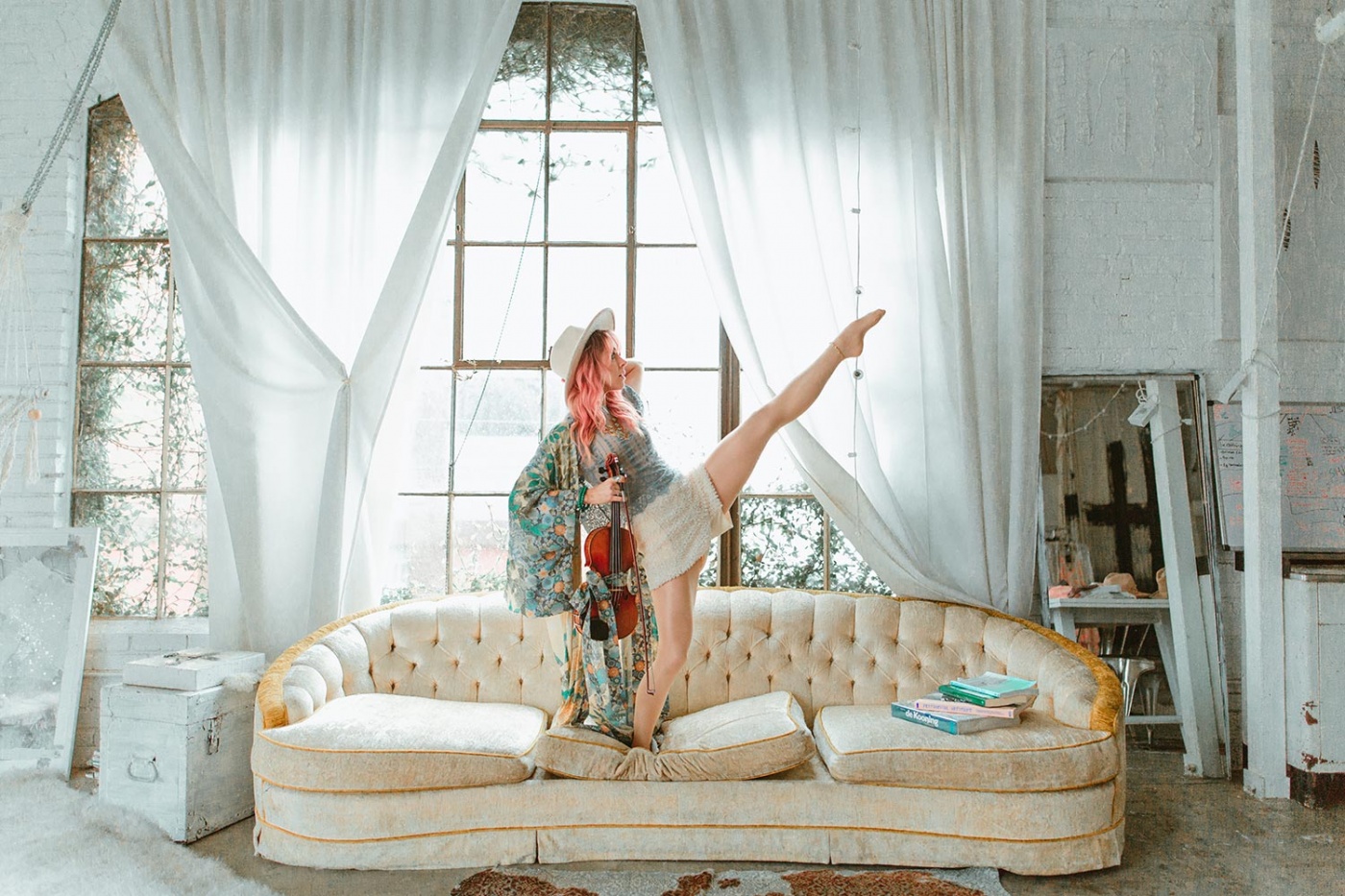Violin Sensation Lindsey Stirling’s Unexpected Rise to Fame
Lindsey Stirling whirls in a trance-like dance with her violin like an enchanting pixie. Known by many as the dancing dubstep violinist, she has captivated millions with her rhapsodic music and exuberant movements, where she sways, leaps and jerks feverishly in tandem to the beat.
Yet offstage, this 33-year-old’s journey to stardom is anything but fairytale-like. Her story is one of human triumph—and the adversity she went through to chase her dreams. From battling with depression and an eating disorder to having anxiety and self-doubt, Stirling has always transcended from within through hard work, grit and resilience.
Stirling’s first claim to fame was when she took part in America’s Got Talent (season five) to kick-start her music career. She had a good run until the quarter-finals where she received soul-crushing comments from judges Piers Morgan, who said scathingly that her performance sounded “like a bunch of rats being strangled” and Sharon Osbourne, who remarked that Stirling could not “fill a Vegas theatre.” As she stared rejection in the face, Stirling was “absolutely devastated” and uncertain if she would ever perform live again.
While many might cower in embarrassment, the enterprising musician took to YouTube as a platform to broadcast and showcase her talent—and it paid off. Currently, Stirling has 12.5 million YouTube subscribers, 1.6 million Instagram followers, two Billboard Awards, a best-selling novel The Only Pirate at the Party, and performed in front of sold-out arenas across the world. Her two spell-binding albums, Shatter Me (2014) and Brave Enough (2016) both reached second place on the Billboard 200, cementing her unique and idiosyncratic brand of music.
In 2018, all that fervent attention reached a crescendo when Stirling was asked to compete again on the new spinoff America’s Got Talent: The Champions. She declined, fully aware that she was already making waves on her own and pioneering a new paradigm for aspiring musicians with her amalgam of dance and classical and hip-hop violin. Once deemed by industry heavyweights as “not marketable,” Stirling has defied all odds to carve a niche for herself—proving that there is a place for this violin virtuoso after all.
High Net Worth: Throughout your career, what were some of the watershed moments for you, including the lowlights and highlights?
Lindsey Stirling: I feel like these ‘watershed’ moments are frequent and ongoing; I’m constantly trying to improve and adjust my goals to focus on the things that matter most. With regard to my career, performing for America’s Junior Miss Pageant when I was 18, was the first time I truly knew that performing was what I wanted to do for the rest of my life. Several years later, my experience on America’s Got Talent felt like ‘waterfalling’ into an abyss. But once I pulled myself out of that humiliating ordeal, it actually fuelled the fire in me because I knew I had to prove everyone wrong—not just for myself, but for anyone out there who has ever been discouraged or told that they weren’t good enough. Some of my greatest watershed moments have been because God put a person in my life exactly when I needed them. One such person is Devin Graham, and there have been many others! I mention Devin because he believed in me, connected me with Marco G (my first producer), filmed “Crystallize” (and many others), taught me everything he knew about YouTube, and gave me that initial boost I needed in my career.

Your music deviates from classical violin playing, and people have described you as “dropping the beat” like a rave fairy. What inspired you to create this unique violin-electronic-dubstep style?
I always loved the violin, but I also love videography, editing, dance, costume design, performing and popular music. I was classically trained and have a tremendous amount of respect for classical music. However, creativity is not particularly celebrated in this realm, as the genre is all about preserving an ancient art form and carrying on that tradition. Musically, living within this traditional box caused me so much frustration that I almost gave up the violin altogether. So I joined a punk rock band, wrote my own songs, and started layering my music with all of those things I loved: dance, costumes, video, and popular music. These were things that broke the mould and brought me joy. It has been my hope that I can inspire others and bring that same joy to others through my music as well.
How did you go about owning that style? You mentioned before in an interview that ‘authenticity’ is a part of it.
Creating something that is marketable, or rather something that my fans and the public want, is essential to being a full-time performing artist. In order to tour, create music and videos, and pay all the people who help make all of that possible, I need to create a marketable, viable “product.” But it’s just as important to create something that is authentic—something that I 100 per cent love. Accomplishing that can be a bit of a balancing act. From the beginning, in order to market myself, I had to reach out, collaborate with other artists and cover popular, highly requested songs. With this added “reach,” I hoped that those whose attention I was able to catch might be tempted to listen to my original creations and keep coming back for more. While I have enjoyed every collaboration and every cover I’ve ever done, I believe I am a true creator.
Troy Carter (Lady Gaga’s former manager) once said this about you: “This girl knew how to move the needle and understood YouTube was a venue to engage fans both online and offline.” What do you think is the cornerstone to your global appeal?
As a young entrepreneur, I was told that what I had to offer was too different. No record label would sign me and managers were not interested. I knew I would be competing with amazing musicians from around the world and had to find a way to stand out. I also believe that, despite my own fears and insecurities, there was something in me that wouldn’t let me quit. I believed God wanted me to succeed, and when God’s on your side, who can stand in your way? Only yourself! My advice when it comes to any dream you have is to get out of your own way.
You used to choreograph your dances when you first started. Do you still do it?
I used to choreograph my own dances because I was on a limited budget and I understood my limitations. For example, I can’t use my arms since they are busy with the violin. I now have access to amazing choreographers and dancers including Addie Byers and Ashley Gonzales; I love their style and energy. They are also some of the most caring people I have ever met and that positive energy shows in their choreography.
Who would be your ideal guest on String Sessions?
I was ecstatic about the musicians who agreed to be on my String Sessions videos! Amy Lee, Bishop Briggs, Gabby Barrett, LP, Jewel, JP Saxe, Julia Michaels, Andy Grammar and Johnny Rzezik. If I could pick another ideal guest or two, I would love to have Ellie Goulding and Taylor Swift on for a session.
If you could choose your favourite song from your entire opus, which would it be and why?
It’s hard to choose just one since every song is meaningful and several have marked important transitions in my life. “Beyond the Veil” was especially meaningful to me, because, at the time, I was feeling a lot of anxiety and self-doubt, worrying that my next album Shatter Me would be a dismal failure. I was struggling emotionally, personally and spiritually. Even as I was working on the song with my producer, I felt that it was ‘sub-par.’ But when I listened to the completed track for the first time several days later, I was filled with hope and conviction that everything was going to be okay.

The song “Transcendence” was written about how you overcame adversity. Could you share a bit more on that and how it shaped you into the person that you are today?
My fight against depression and an eating disorder took a huge toll on my life, and it is not something I can adequately answer here. I have spoken in depth about it in my book. The main lesson I learnt from this was that it was not about me. It was a disorder that did not define who I was. When I made the decision to no longer claim it as part of my identity, but rather as an unwelcome guest, I was finally able to start letting it go. It took a tremendous amount of humility, work, soul-searching and a willingness to seek and receive help in order to overcome that false identity. Through that, I learnt the second truth: 100 per cent recovery is possible. With help, I did it and I know it is possible for anyone to overcome such conditions too.
You have read hateful comments about yourself before. How do you deal with such negativity?
You can’t win them all! It takes courage to put yourself out there. Inevitably, there will be some who appreciate what you have to offer and others who will tear you down. Every person who has ever had something worthy to offer has been both loved and hated for it. It is so easy to allow that one hateful comment to negate 100 good comments, especially when we allow ourselves to believe that their opinion actually matters. Although I try to take comments with a pinch of salt, I do consider if they may be helpful or contain some truth.
Your latest album “Artemis” is named after the goddess of the moon. Is there any reason why you selected this title?
When I was considering a theme for my album, I was looking at the moon one night. I thought about how the moon waxes and wanes, and how even when the moon is completely covered in shadow, it’s still there. Like the moon, we go through cycles in life. And it’s during those times when life seems darkest, that I tell myself to remember that the light will come again.
That’s a beautiful perspective to have. Has the ongoing pandemic taught you anything about life?
I’ve realised that everything can change and it’s important to be adaptable. If things continue as they are, it is entirely possible that touring could come to a massive halt. The past six months have caused me to question my priorities and ask myself, ‘What would I do if I couldn’t perform anymore? What do I rely on? And if all of those things were taken from me, would I have the faith and strength to stand up and keep fighting on? Would I fall apart or would I find other ways to contribute?’ If I’m truly honest with myself, I realise that I still have significant personal work to do to prepare for whatever comes. In the meantime, I will continue to create and give back in any way I can, because service is what makes this life meaningful and worthwhile.
What do you see yourself doing more of in future?
We talked about authenticity earlier. Being authentic while still being progressive, and creating material that sounds new, while at the same time making sure it sounds like me is definitely one of my biggest challenges. I have a lot of ideas, and as of now, I’m looking forward to hopefully touring next year. I would love to create a meditation album. I’ve also been working on a potential Broadway play. Recently, I auditioned to be on a reality TV show, and while I wasn’t chosen this time, I still want to keep knocking on that door. Regardless of what the future holds, I’m grateful for all of the opportunities I’ve had thus far.


